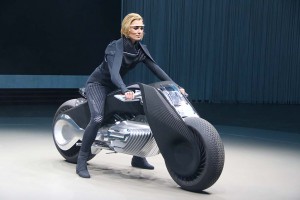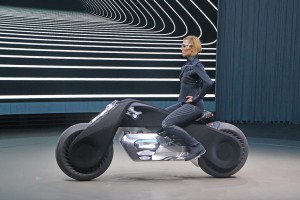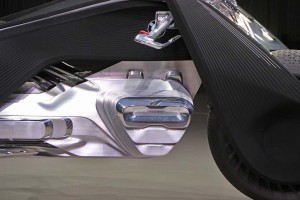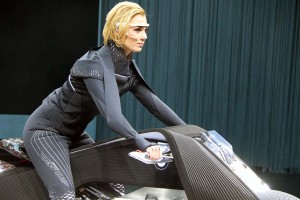All that’s missing was the neon. The motorcycle that rode into BMW’s news conference in Los Angeles on Tuesday might have well driven off the set of the next Tron sequel.
But the Vision Next 100 is more than just science fiction, at least to BMW which sees the exotic show bike as a glimpse of what tomorrow’s high-tech motorcycle will look like. Cleaner, safer, connected, the Vision Next 100 suggests that many of the changes reshaping the automobile will also transform tomorrow’s two-wheelers.
“Our world is rapidly changing, and individual mobility must evolve to meet the needs of a complex society,” said Harald Krueger, CEO of Bayerische Motoren Werke, during a news conference wrapping up a nearly year-long celebration of the automaker’s 100th anniversary.
Rather than simply looking back at a long and celebrated history, however, the carmaker’s centennial strategy has focused on the future, with the Bavarian automaker rolling out high-tech concept vehicles for each of its four brands: BMW, Mini, Rolls-Royce and BMW Motorrad.
The first of these “Vision Next 100” models debuted at the automaker’s Munich headquarters last March, followed by Rolls and Mini. Its motorcycle division wrapped things up with a striking black and chrome motorcycle featuring augmented reality technology, a “bionic” frame and a gyroscopically stabilization system that allows it to stand upright even when completely stopped.
(Codenamed 103EX, this is definitely not your (rich) father’s Rolls-Royce. Click Here to check it out.)
The goal was to give a rider “absolute freedom,” suggested Edgar Heinrich, the chief designer for BMW Motorrad. A challenge was to use technology to enhance the pure, unadulterated, (pleasure) of motorcycle riding,” rather than dumb it down.
Like the other Vision concepts, the bike did tie to BMW’s past, subtly carrying over some of the design elements first seen on the company’s first motorcycle, the 1932 R32. That included the triangular frame, white lines and “boxer” engine.
But each introduced a very futuristic touch. The frame of the concept, and other components, such as the fenders, are made of ultra-light and super-strong carbon fiber. And the frame is able to flex to enhance the bike’s steering.
The engine, meanwhile, might superficially resemble the classic, opposing-piston gas engine design BMW favors, but it’s actually an electric drivetrain. In one of the more intriguing touches, the outer housing of the engine – where the pistons would normally be housed – can extend outward while driving, or pull into the frame when stopped.
Perhaps the most striking feature is the Vision bike’s ability to stand upright on its own. That gyroscopic system is something that potentially could make it into production in the coming decade, Heinrich hinted.
Known inside BMW as “the Great Escape,” the concept motorcycle is a look several generations down the road, but a number of elements, like the gyro system, could find practical application.
There are no gauges on the bike itself, for example, all traditional read-outs displayed for the driver through a pair of augmented reality goggles. What’s seen varies, depending upon where the driver is looking – or what information they ask for. Among other things, the googles could show the best line around a track or warn of unseen obstacles.
Augmented reality systems are starting to make the move into the consumer electronics world, so this technology could be available on a motorbike in the not-too-distant future.
The Vision Next 100 bike also features a number of safety systems designed to prevent crashes. The motorcycle would be so safe, BMW officials claimed, that there’d be no need for protective helmet or padded clothing.
(BMW planning to launch autonomous car by 2021. Click Here for more.)
One thing the maker notably left off the concept two-wheeler was the ability to drive autonomously, something it emphasized on its BMW, Mini and Rolls-Royce centennial show cars. Heinrich insisted motorcycle riders want to engage with their bikes. But not everyone is so sure.
An autonomous concept, dubbed MotoBot was shown at last year’s Tokyo Motor Show by Yamaha. And some industry futurists suggest that fleets of such vehicles could prove especially useful in navigating traffic around increasingly crowded megacities.
But with or without autonomous capabilities, it’s difficult to deny that BMW’s Next 100 provides a visually striking, technologically enticing Vision of the future for motorcycle riders.
(Mercedes launching all-new EQ sub-brand for a wave of upcoming battery cars. Click Here for the story.)




